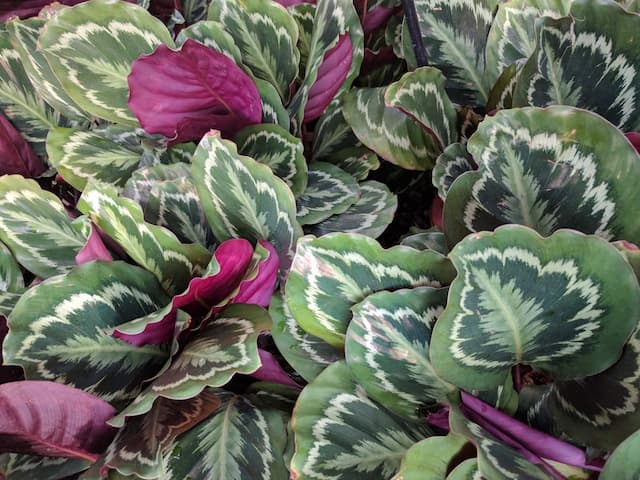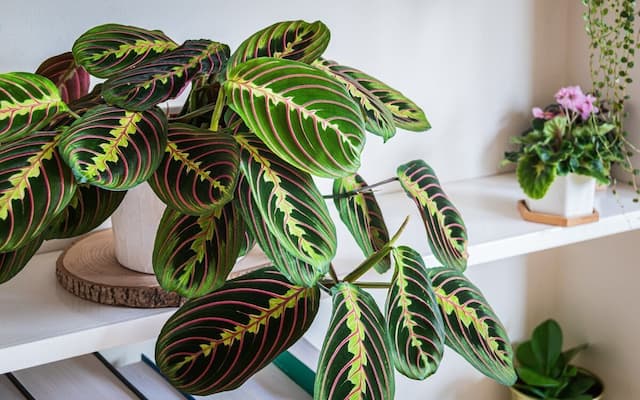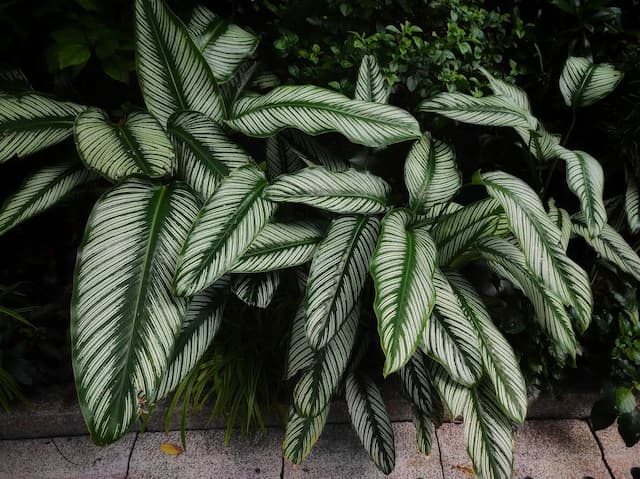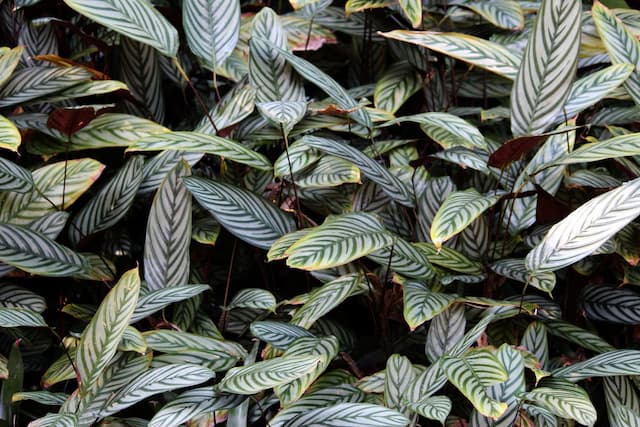Prayer Plant Maranta leuconeura var. erythroneura

ABOUT
The plant commonly known as the Red Prayer Plant is an attractive houseplant recognizable for its unique and decorative leaves. It's famous for its striking foliage, which features a herringbone pattern. The leaves are oval-shaped and have a glossy texture, presenting a rich green hue with a distinctive, deep red vein running along the midrib. From this main vein, smaller veins stretch out towards the edges of the leaves, where they appear like a feathered pattern in a lighter green or sometimes white coloration, creating a stunning contrast against the dark green background. Aside from its colorful veins, the Red Prayer Plant’s leaves have a unique behavior in response to the light cycle, where they fold upward at night as if in prayer, hence its common name. This movement is part of what makes the plant intriguing to plant enthusiasts. Additionally, the undersides of the leaves exhibit a reddish-purple color, further contributing to its overall vibrant appearance. This plant provides a visual highlight in any indoor space thanks to its vibrant hues and dynamic foliage.
About this plant
 Names
NamesFamily
Marantaceae.
Synonyms
Red Prayer Plant, Red Vein Maranta, Red Maranta, Herringbone Plant, Tricolor Maranta, Red-veined Prayer Plant.
Common names
Maranta leuconeura var. kerchoveana, Maranta leuconeura var. massangeana, Maranta massangeana.
 Toxicity
ToxicityTo humans
The plant commonly known as Red Prayer Plant (Maranta leuconeura var. erythroneura) is not considered toxic to humans. Ingesting any part of this plant typically does not lead to poisoning or adverse health consequences. Therefore, there are no specific symptoms associated with poisoning from the Red Prayer Plant, as it is generally safe around humans.
To pets
The Red Prayer Plant (Maranta leuconeura var. erythroneura) is also non-toxic to pets. It is generally safe for cats and dogs, and ingestion of this plant should not cause any symptoms of poisoning or serious health issues. Pet owners can feel confident keeping this plant within reach of their animals without the risk of toxicity.
 Characteristics
CharacteristicsLife cycle
Perennials
Foliage type
Evergreen
Color of leaves
Variegated
Flower color
White
Height
1-2 feet (30-60 cm)
Spread
1-2 feet (30-60 cm)
Plant type
Herb
Hardiness zones
11
Native area
Tropical Americas
Benefits
 General Benefits
General Benefits- Decorative Appeal: The Red Prayer Plant has strikingly beautiful red veins against dark green leaves, enhancing the aesthetic of any indoor space.
- Low Maintenance: It's relatively easy to care for, requiring only moderate light and watering conditions.
- Humidity Loving: Thrives in humid conditions, making it a great choice for bathrooms or kitchens where moisture levels are higher.
- Pet Friendly: The Red Prayer Plant is non-toxic to pets, making it safe to keep around cats and dogs.
- Movement: The leaves fold up at night and unfold in the morning, adding a dynamic element to its appeal.
- Small Size: Typically compact, this plant fits well in smaller spaces and is ideal for shelves or desktops.
- Propagation Ease: Can be easily propagated from cuttings, allowing you to share the plant with friends and family.
 Medical Properties
Medical PropertiesThis plant is not used for medical purposes.
 Air-purifying Qualities
Air-purifying QualitiesThis plant is not specifically known for air purifying qualities.
 Other Uses
Other Uses- The red-veined prayer plant's leaves can be used in floral arrangements or as a natural decoration, adding a unique pattern and color to bouquets or indoor displays.
- This plant can be used in terrariums or vivariums, providing a lush, tropical feel and serving as a ground cover or backdrop for other plants and small creatures.
- As a pet-safe plant, it is suitable for homes with cats and dogs, making it an ideal choice for pet owners seeking non-toxic indoor foliage.
- The striking appearance of the red-veined prayer plant can be used in art and photography as a subject or background, emphasizing its vivid patterns and movements.
- Red-veined prayer plant leaves can serve as inspiration for textile designs, their intricate patterns replicated in fabrics for clothing or home decor.
- In educational settings, this plant can be used to demonstrate nyctinasty – the process by which a plant's leaves respond to light and darkness.
- Can be given as a gift to symbolize gratitude or appreciation, as the leaves resemble hands in prayer, which is often a gesture of thanks.
- As a companion plant in mixed containers, the red-veined prayer plant can complement flowering plants with its deep green leaves and red veins.
- The plant can serve as a living art installment in offices or homes, as its changing positions throughout the day offer a dynamic visual experience.
- Used for stress relief, the plant’s rhythmic movement and soothing colors can have a calming effect on the environment, potentially reducing stress.
Interesting Facts
 Feng Shui
Feng ShuiThe plant_name is not used in Feng Shui practice.
 Zodiac Sign Compitability
Zodiac Sign CompitabilityThe Prayer Plant is not used in astrology practice.
 Plant Symbolism
Plant Symbolism- Prayer: Maranta leuconeura var. erythroneura, commonly known as the Red Prayer Plant, is symbolic of prayer because of its fascinating nyctinasty - the leaves fold together like hands in prayer at night and open again in the morning light.
- Gratitude: The Prayer Plant's response to light is also seen as a gesture of gratitude, continuously giving thanks to the sun throughout its daily cycle of movement.
- Devotion: This plant's common name is reflective of its symbolic association with devotion, due to its daily rituals of folding leaves, mimicking an act of devotion.
- Focus: Often thought to represent focus, the Red Prayer Plant's leaves display intricate patterns that can symbolize an attentive and detailed mindset.
 Water
WaterThe Red Prayer Plant (Maranta leuconeura var. erythroneura) should be watered when the top inch of the soil feels dry to the touch, which may equate to approximately once a week, though the frequency can vary depending on environmental conditions. Use lukewarm water and gently pour it over the soil until it begins to drain out of the bottom of the pot, ensuring deep hydration without waterlogging. On average, this might be between 8 to 16 ounces of water for a medium-sized indoor pot, though factors like pot size, indoor humidity, and temperature could affect the precise amount.
 Light
LightThe Red Prayer Plant thrives in bright, indirect sunlight and should be placed in a spot where it can receive this type of light throughout the day, such as near an east-facing window with sheer curtains. Direct sunlight can be harmful and should be avoided to prevent scorching its delicate leaves.
 Temperature
TemperatureThe ideal temperature range for the Red Prayer Plant is between 65 and 85°F, ensuring the plant stays warm as it does not tolerate cold well. Maintain a minimum temperature of around 60°F to avoid damage. This tropical plant prefers consistently warm conditions without sudden temperature drops or cold drafts.
 Pruning
PruningThe Red Prayer Plant may require occasional pruning to remove yellow or brown leaves, to encourage bushier growth, and to maintain its attractive appearance. This can be done every few months or as needed. Pruning is best done in the spring or early summer when the plant is actively growing.
 Cleaning
CleaningAs needed
 Soil
SoilThe Red Prayer Plant thrives in a well-draining, nutrient-rich potting mix with a slightly acidic to neutral pH of 5.5 to 7.0. A suitable soil recipe could be a mix of 50% peat or coco coir, 20% perlite, and 30% potting soil to ensure adequate moisture retention and aeration.
 Repotting
RepottingThe Red Prayer Plant should be repotted every 1-2 years or when it has outgrown its current pot. Refresh the soil during repotting to provide new nutrients and room for growth.
 Humidity & Misting
Humidity & MistingRed Prayer Plants prefer high humidity levels, ideally between 60% and 80%. To maintain these conditions, placing a humidifier nearby or using a pebble tray with water can be beneficial.
 Suitable locations
Suitable locationsIndoor
Keep in bright, indirect light and high humidity.
Outdoor
Shelter from direct sun; best in warm, humid climates.
Hardiness zone
11-12 USDA
 Life cycle
Life cycleThe Prayer Plant (Maranta leuconeura var. erythroneura) begins its life cycle when a seed germinates, typically in warm, damp soil, where the embryonic plant emerges with its initial root and shoot. As it grows, the plant develops characteristic oval leaves with red veins and a habit of folding its leaves at night as if in prayer, hence its common name. The Prayer Plant enters a vegetative stage, where it focuses energy on leaf and root growth, preferring bright, indirect light and high humidity to thrive. When mature, it rarely blooms indoors, but if it does, small white flowers may appear in favorable conditions, although they are not as showy as the foliage. Following flowering, if conditions permit, the plant may produce small berries containing seeds, though houseplants primarily propagate via division or cuttings. Once propagated, the new plants will continue the cycle, maturing and eventually being able to produce their own offshoots.
 Propogation
PropogationPropogation time
Spring-Early Summer
The Maranta leuconeura var. erythroneura, commonly known as Red Prayer Plant, can be propagated through division or cuttings, but the most popular method is by taking stem cuttings. The best time to propagate is during the spring or summer months when the plant is actively growing. To propagate by stem cuttings, you should select a healthy stem with at least one or two leaves and cut it just below a node using a sharp, sterilized blade. The cut end can then be placed in water or a moist potting mix. If you opt for water, the container should be kept in indirect light and the water refreshed regularly until roots form, which usually takes a few weeks. Once the roots are about an inch (approximately 2.5 centimeters) long, the cutting can be potted in soil and should be kept moist as it establishes itself in its new pot.




